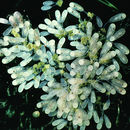en
names in breadcrumbs


While small in size, Octopus joubini has a rapid growth over a relatively short life span (4-8 months). Their small size seems to be due to their small hatching size and the short duration of their rapid growth. They have keen senses. Their vision is so good that they are able to see a diver at least when he sees them, if not before.
At present there is an argument over whether the Octopus joubini is a synonym of either O. mercatoris or an as-yet undescribed species. Possible differences between the two supposed species include coloration, egg size, and hatchling ecology.
Possible effect on crab populations in the area.
Used in research, both behavioral and biomedical.
Mainly feed on crabs, e.g., Uca fiddler crabs, but also consume snails. Prefer crabs, possibly because they come into more contact with them, and crabs are more active than snails. The octopus seems to spend long periods of time pulling snails out of their shells before consuming them, but they can kill and eat a crab in one minute or less.
Tropical Western Atlantic:
Florida, Gulf of Mexico, Caribbean Sea to Guyanas, Bahamas, West Indies.
Biogeographic Regions: atlantic ocean (Native )
Inhabit empty shells among coral, near low tide line and below in shallow water. They use crevices, empty clam shells, or spaces in a reef face to eat and rest.
Aquatic Biomes: benthic ; reef ; coastal
Small; maximum length (including arms) approximately 15 cm. Like all octopuses, Joubin's octopus has 8 arms. One arm, the ligula, is modified in males to form a sex organ. Octopus joubini has smooth skin with small pimples scattered at intervals.
Other Physical Features: ectothermic ; bilateral symmetry
Actual mating time is usually brief, about 5 minutes, as compared with other species like the Octopus dofleini, which mates for 2-3 hours. Amount of contact and sex of the initiator seems to vary. As a result of its small size, the animal is vulnerable to many predators. A shorter mating time shortens the period of vulnerability to these predators. It can occasionally cause problems, however. The sperm is passed to the female through a spermatophore that the males, using a special arm, place in the female's mantle cavity. The spermatophore evaginates in the female's oviduct, releasing sperm. Usually males would hold the spermatophore in the female until this process is complete, but in this case the male cannot because the fertilization takes too long. The eggs produced are usually fairly large, 6-8 mm in length. The females begin spawning from 4-5 months after hatching, with death shortly after 30-45 day brooding period.